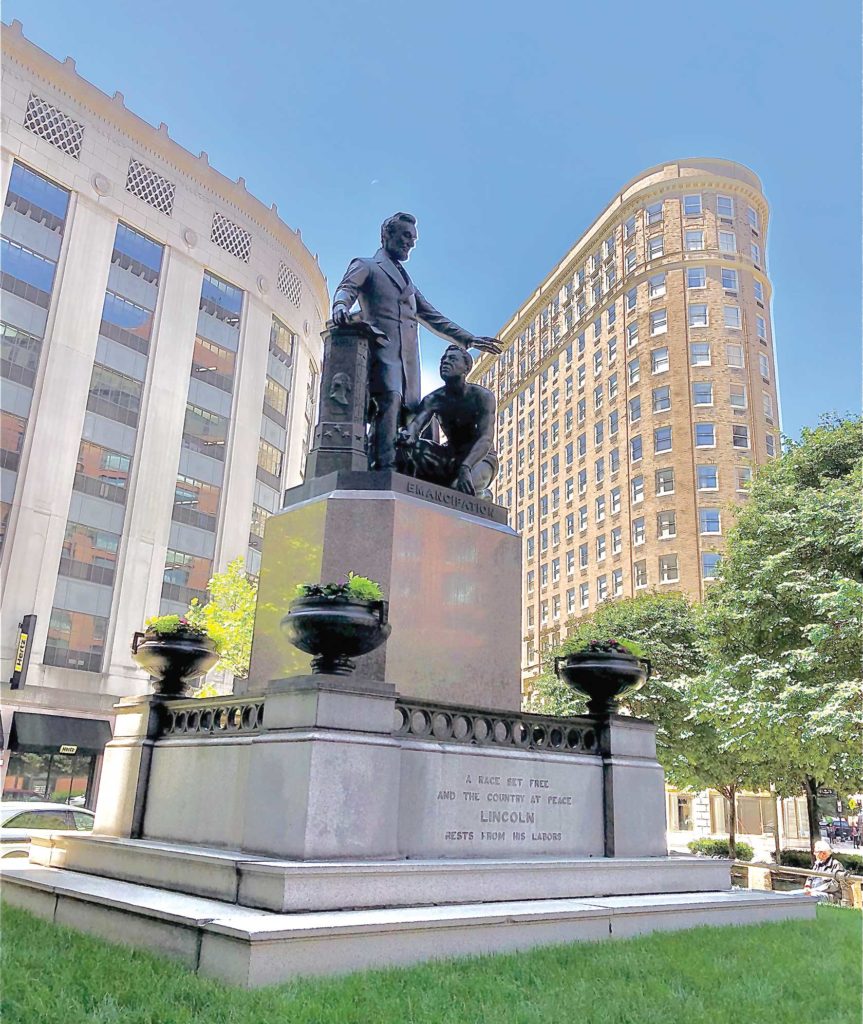
The racial reckoning sweeping across America has triggered a long-overdue shift in attitudes towards offensive cultural icons.
Images and symbols long derided by people of color as racist, demeaning or outright treasonous, like Confederate flags and statues revering the traitorous generals of the South’s “Lost Cause,” are being furled or removed at a pace unthinkable just a few years ago.
The idea that the Stars and Bars — the supreme emblem of the slaveholders’ rebellion — will no longer snap in the breeze like a rebel yell at NASCAR rallies is no longer an aspiration but a fact, one prompted by the actions of the improbably named Bubba Wallace, the racing circuit’s lone African American driver.
Protesters are taking ropes and sledgehammers to symbols of oppression, from equestrian statues of Robert E. Lee to Christopher Columbus monuments, but elected and appointed officials are also whisking them away by decree, including a Lee monument in Richmond, Virginia, the former capital of the Confederacy.
In Washington, D.C., the guardians of Statuary Hall on Capitol Hill are considering the removal of numerous marble monuments placed there by former Confederate states to honor leaders of the insurrection.
This public soul-searching, not seen since the Civil Rights Movement, was prompted by the death of George Floyd beneath the knee of a Minneapolis police officer just a few weeks ago. Massive demonstrations initially focused on police violence but have since broadened to look at issues of housing, education, health care and employment and, more recently, the landscape of public culture.
And not just in America.
Crowds in Bristol, England, pulled down the statue of the port city’s 17th-century slave-trader and dumped it into the harbor.
Protesters in Antwerp defaced the marble visage of King Leopold II, the Belgian monarch who privately owned the riches of the Congo, where, under his reign as Sovereign of the Congo Free State, some 15 million Africans were worked to death.
Like the colonial capitals of Europe, Boston has a target-rich landscape of names and images in bronze and stone inviting erasure or removal.
An ongoing campaign to rename Faneuil Hall is getting a fresh hearing from City Hall. Activists led by New Democracy Coalition founder Kevin Peterson have sought to identify a new name unmoored to the slave-holding history of Peter Faneuil, the 18th-century benefactor of the landmark meeting hall and market.
In Park Square, a statue of Abraham Lincoln looming like an overlord over a crouching, manacled black man has become the subject of a petition for removal, the appeal addressed to Boston Mayor Marty Walsh. The signature drive, led by Tory Bullock, draws on over a century of controversy surrounding the bronze memorial to the “Great Emancipator” for his role in freeing African Americans held in bondage in states under rebellion.
The Boston statute, an exact replica of the original monument in Washington, D.C.’s Lincoln Park, shows the fully clothed 16th president standing over a half-clothed slave, in theory rising from forced servitude. From some angles, the black figure seems to be shining the Railsplitter’s shoes — hence the derisive “Bootblack Statue” nickname, which has endured for over a century.
The first funds for the Washington statue, placed at the center of a park in a fashionable residential neighborhood a few blocks from the U.S. Capitol, were raised by freed slaves. “The Freedmen’s Memorial Monument,” as it became known, was sculpted by Thomas Ball, a Chelsea native working in Europe. The design, approved by an all-white commission, was altered to show the rising slave with his right arm outstretched rather than the more submissive pose of resting on the ground.
The change satisfied some, but not the esteemed abolitionist Frederick Douglass, who gave the keynote speech at the 1876 dedication, which was witnessed by President Ulysses S. Grant and a throng of 25,000 spectators. The statue, he said in a 2017 account cited by Boston University lecturer Raul Hernandez, “showed the Negro on his knee when a more manly attitude would have been indicative of freedom.”
During a visit to the Boston replica shortly after the Boston Globe published an article about Bullock’s petition drive, several people stood on the sidewalk taking pictures of the statue, while others circled the base, examining the monument from different angles.
Marlo Stanfield, a St. Louis native who has lived in Boston for over 20 years, said he found the statue unsettling.
“It would be nice to see that the one emancipated is standing and unshackled,” he said. “It’s kind of a metaphor saying ‘you’re kinda free but not really.’ Even the look in Lincoln’s face says, ‘Know your place.’ You don’t lift somebody up by looking down at him. You lean over and pick him up.”
The Park Square monument came to the city as a gift from businessman Moses Kimball, Ball’s former employer, and was erected in 1879.
Historian and former state Rep. Byron Rushing calls taking down Confederate monuments a “no-brainer” but says taking action on public statues like the emancipation memorial figures requires more caution. Citing their complicated history, Rushing said they may be worth saving.
“Before we do anything, I think we should experiment,” he said. “The history is so intriguing. Slaves themselves decided they wanted this monument. And the original version had only Lincoln, and when he was pressed to add a slave, he used an idealized head. Black folks sent him a photograph of an emancipated slave to use, and they felt they won by having Ball use a real black person. Of course, Ball then used mirrors in his studio to draw his own body as the slave’s torso. He was just a complete asshole.”
Rushing said deliberations over the statue’s fate should include ideas about interactive exhibits and lengthy explanatory panels. “I don’t want to lose that history,” he said. “I want to tell it.”
While the fate of the Emancipation Statue is debated, one rarely cited fact about Confederate monuments exposes the fragile arguments of their defenders: Robert E. Lee himself opposed them.
According to Lee biographer Jonathan Horn, the former commander of the Army of Northern Virginia consistently turned down requests to support the erection of monuments to Confederate leaders and even supported getting rid of the Confederate flag after the Civil War ended.
“He didn’t want it flying above Washington College, of which he was president after the war,” wrote Daniel Brown, citing Horn in a 2017 Business Insider article.
No Stars and Bars were displayed at his funeral nor did former Confederate soldiers don their old uniforms and “neither did the body they buried.”
Four years before his death in 1866, Lee was asked to back the erection of a memorial to Gen. Thomas “Stonewall” Jackson, a fellow West Pointer and one of his top commanders.
“As regards the erection of such a monument as is contemplated,” wrote Lee, “my conviction is, that, however grateful it would be to the feelings of the South, the attempt, in the present condition of the country, would have the effect of retarding rather than accelerating its accomplishment, and of continuing if not adding to the difficulties under which the Southern people labor.”
To Lee, the “Lost Cause” really was lost — lost and better abandoned. Seven generations of African Americans born since the end of the Civil War have made the same argument. The holdouts finally seem to be listening.






